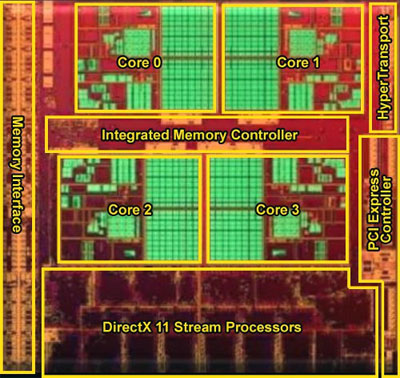AMD will in July play its second card for the integrated processor market. We recently shared detailed specifications for the AMD A series of APUs that will sport two to four cores and a DirectX 11-grade graphics processor. We have taken a closer look at how the AMD A series GPUs should perform.
AMD develops its new APU family under the code name Llano, the first for desktops with integrated graphics. The AMD E series, also known as Brazos, is already out, but has its primary focus on the mobile market and energy efficient systems. Despite that the integrated graphics processor brings performance that can often measure up to Intel’s integrated graphics of Sandy Bridge.

AMD Llano APU
With Llano AMD raise the bar and increase the number of stream processors from 80 in the AMD E series up to 400 with AMD A8 series. We are talking serious graphics performance that can compete with discrete PCIe graphics cards, something we’ve summarized below. Note that the information is based on leaked and unconfirmed information and may change before launch day.
| APU/GPU | Stream pro. | GPU-klock | Memory | Memory clock. | TDP |
| AMD A8 APU | 400 st. | ~ 594 MHz | DDR3 | 1 866 MHz | 65/100W* |
| AMD A6 APU | 320 st. | ~ 443 MHz | DDR3 | 1 866 MHz | 65/100W* |
| AMD A4 APU | 160 st. | ~ 594 MHz | DDR3 | 1 866 MHz | 65W* |
| AMD E2 APU | 80 st. | ~ 443 MHz | DDR3 | 1 600 MHz | 65W* |
| AMD HD5670 | 400 st. | 775 MHz | GDDR5 | 4 000 MHz | 64W |
| AMD HD5570 | 400 st. | 650 MHz | DDR3/GDDR5 | 1 800/4 000 MHz | 39W |
| AMD HD5550 | 320 st. | 550 MHz | DDR3/GDDR5 | 1 800/4 000 MHz | 39W |
| AMD HD5450 | 80 st. | 400-650 MHz | DDR2/DDR3 | 800/1 600 MHz | 19W |
* AMD A series specifies total TDP for both CPU and GPU
We see that AMD thanks to the more efficient 32 nanometer technology and higher power consumption can scale up the number of stream processors to really competitive levels. The top models of the AMD A8 series has 400 stream processors, which is the same aount as AMD’s mid-range card Radeon HD 5670. But we can’t expect equal performance in the Llano APU, since there is more than just the number of stream processors that affect performance.
The major differences between the integrated GPUs and AMD’s discrete graphics cards is in the surrounding infrastructure. The AMD A series supports DDR3 with clock frequencies up to 1866 MHz, which is a big step up from the 1066 MHz with Brazos. The memory controller will be extra important in Llano where up to four x86 processor cores and 400 stream processors will fight for its attention and bandwidth.
AMD showing the integrated GPU of Llano APU
We still don’t know exactly how AMD has solved any possible bandiwdth problems, and the clock frequencies it will allow for its integrated GPUs. Considering the speficaitions above we should expect performance on par with the Radeon HD 5500 series, at least when the discrete circuits are paired with slower DDR3 memory.
That AMD is baosting the GPU of Llano is quite obvious and judging from the speficiations that has appeared online it should run circles around Intel’s Core i3 Sandy Bridge processors, which is the intended effect. How the CPU portion of the AMD A series stands up to the same competition is harder to say. At the end of July we should know for certain.





















Leave a Reply